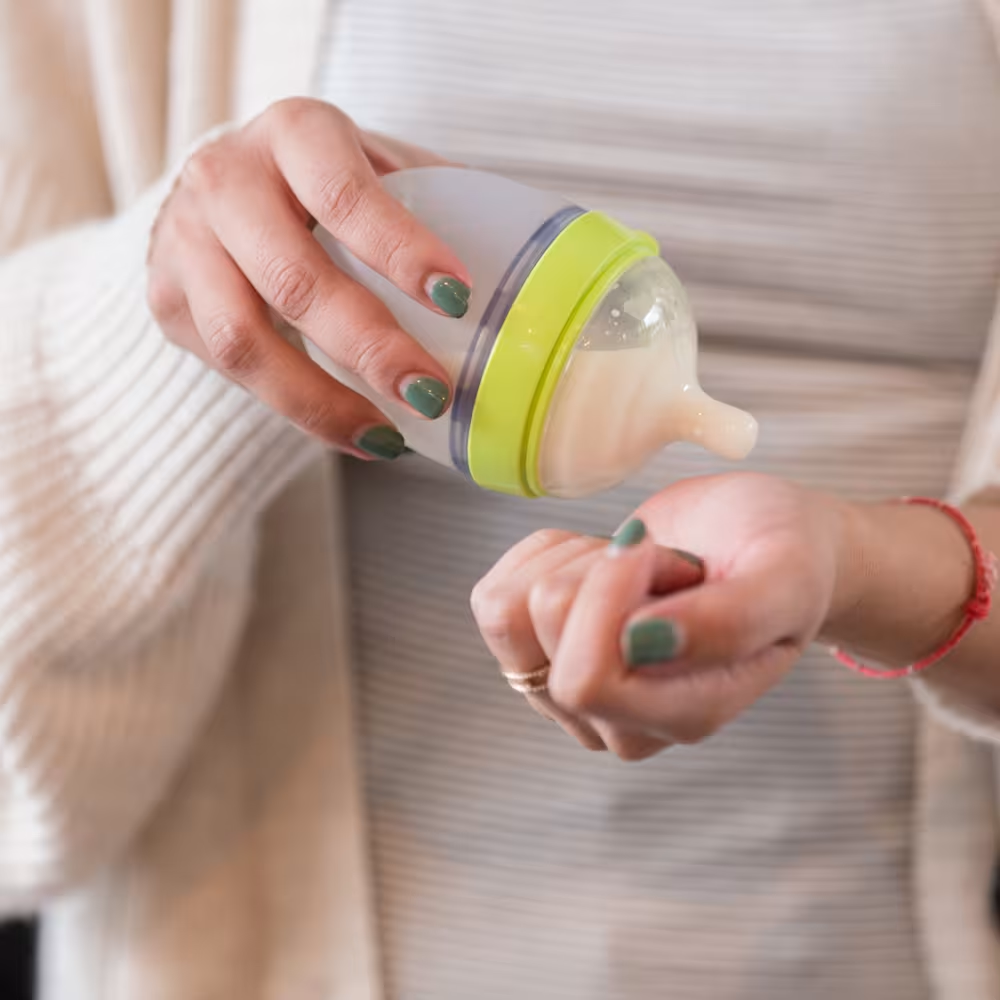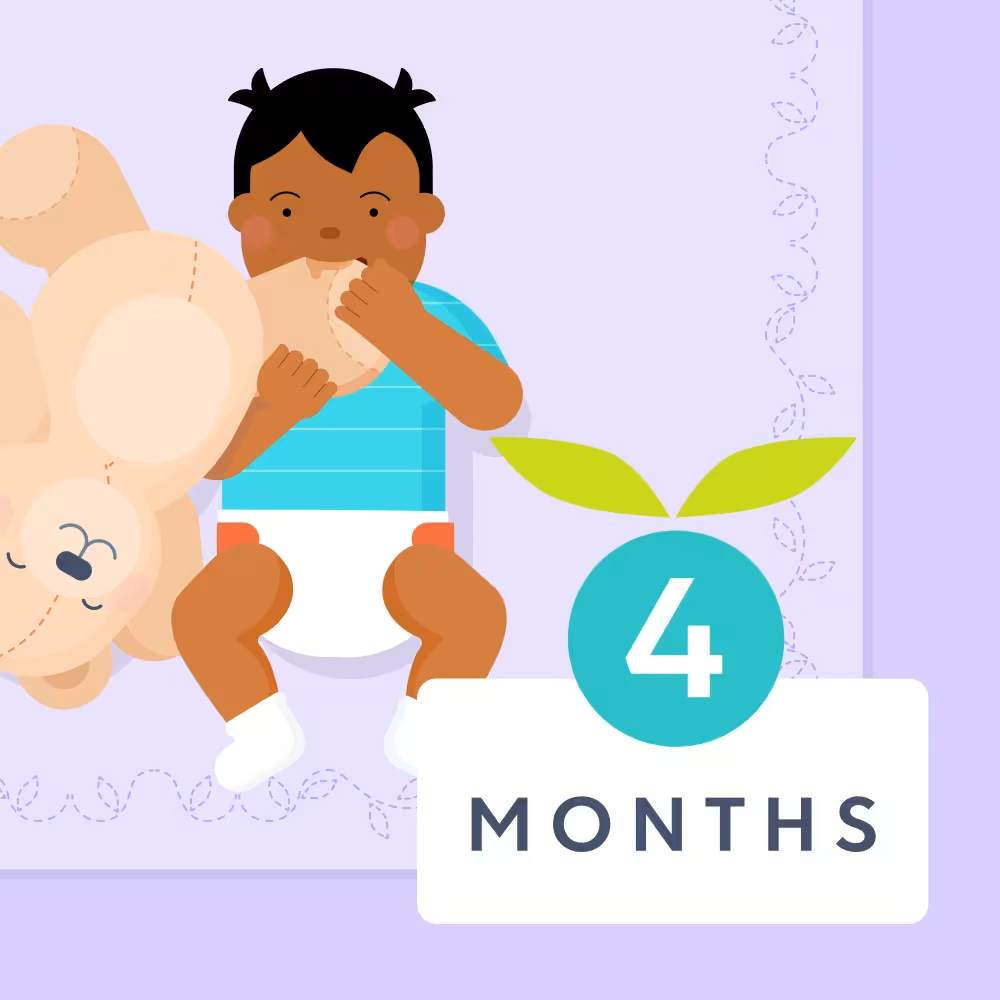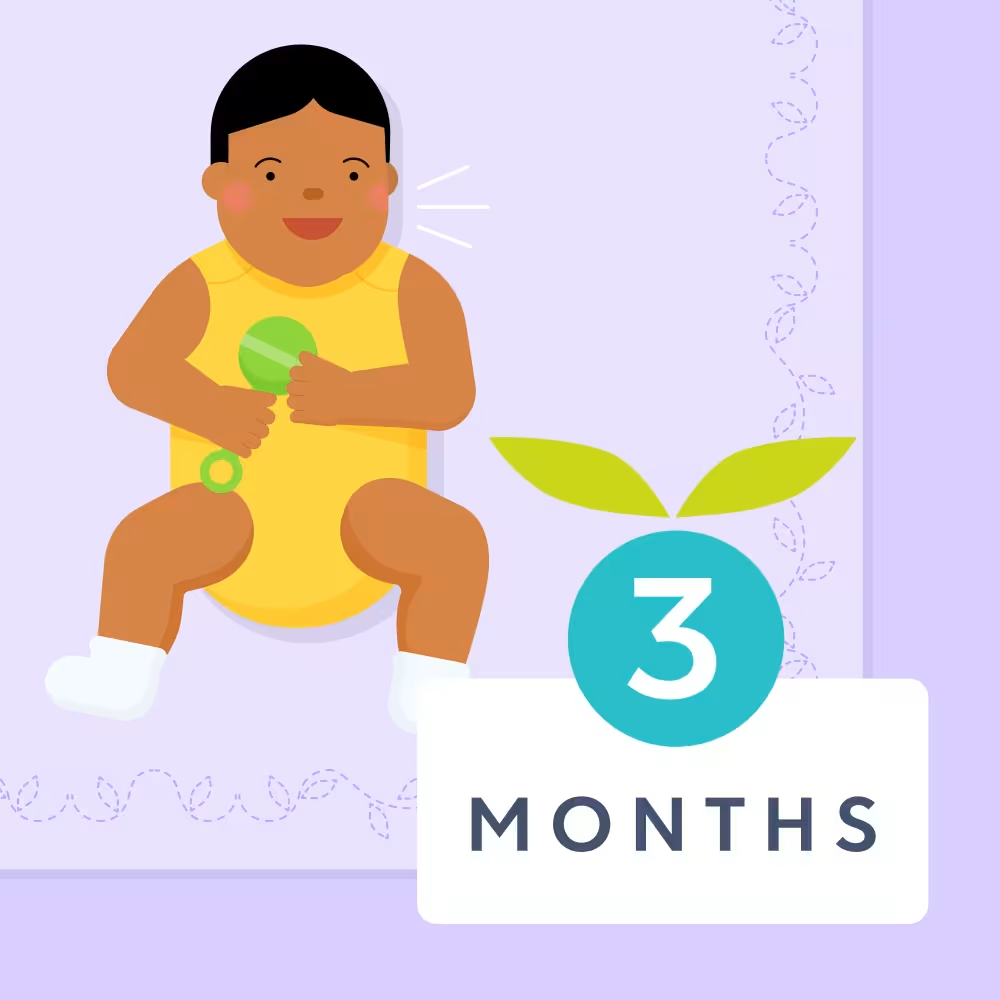3 - 4 month old baby feeding schedule: How much should they eat?
Updated Dec 04, 2025

At 3 - 4 months old, many babies are more alert, enjoy kicking and playing around, and start to babble and mimic facial expressions. It can be an exciting shift!
These new party tricks may work up quite the appetite, though. When it comes to feeding, they eat breast milk, formula, or a combination of both. You might notice they’re eating a bit more in one sitting, spacing feeds out just a little during the day, and (cue the happy dance) possibly giving you a longer stretch of sleep overnight. Some babies still need those frequent snuggles though! (We’ll talk about that later on.)
In this article, we’ll walk you through everything you need to know about feeding a 3 - 4 month old baby including a sample schedule, how much your little one needs to eat, and what to expect out of their nighttime eating.
Table of Contents
How much to feed a 3 to 4 month old: Food chart
By 3 – 4 months, your baby’s appetite is growing right along with them. While their menu is still all breast milk, formula, or a combination of both, how much they take in (and how often) might be shifting. Here’s what to know about average amounts for breastfed and formula-fed babies at this stage.
How much should 3 month olds eat?
Feeding frequency | Amount per feeding | Total feedings per day |
3 hours if breastfeeding, 3 - 4 hours if formula-feeding during the day with longer stretches overnight | 3 - 4 ounces if breastfeeding, 4 - 6 ounces if formula-feeding and taking fewer feeds per 24 hours | 8 - 12 in a 24-hr period |
At 3 months, it's recommended to continue listening to your baby’s hunger cues and feeding on demand. Think of yourself as a short order cook for just a season! The number of feedings will likely remain between 8 - 12 feedings per 24-hour period. However, at this age the time between feeds may start to vary, with longer stretches between some feedings. It’s common to see shorter feeds during the day (even as short as 10 minutes) with cluster feeding patterns appearing at night.
For breastfed babies, that often means eating every 3 hours during the day and every 3 - 6 hours overnight, consuming roughly 3 - 4 ounces [] at each feeding.
For formula-fed babies, you may see feeds every 3 - 4 hours during the day and every 3 - 8 hours overnight, estimating 4 - 6 ounces of formula [] at each feeding.
Of course, these are averages. Your baby’s appetite may be a little smaller or slightly larger than the “textbook” numbers. Trust their cues. If anything feels off or if you have concerns about your baby’s growth, your pediatrician is your best go-to.
Signs of a 3 month growth spurt
Every baby grows on their own timeline, but it’s common for little ones to hit a noticeable growth spurt around 3 - 4 months old []. In this stretch of a few days, your baby might suddenly seem hungrier than usual – such as eating more often or eating larger amounts. Following your baby’s hunger cues and feeding on demand will ensure they get enough to eat during a growth spurt.
During a growth spurt, you might notice:
More frequent feeds (day and night)
Bigger appetite at each feeding
Restless sleep or shorter naps
Extra clinginess or fussiness
Spurts of new skills (rolling, babbling)
How much should 4 month olds eat?
Feeding frequency | Daily intake | Amount per feeding | Total feedings per day |
Divide the daily total number of feeds by the total daily volume to indicate the volume needed. Eating every 3 - 4 is typical. | 18 - 32 ounces (Approximately 2½ ounces of infant formula a day for every pound of body weight) | 3 - 4 ounces if breastfeeding, 4 - 6 ounces if formula-feeding and taking fewer feeds per 24 hours | 8 - 12 in a 24-hour period |
By around 4 months, many babies have settled into a more predictable feeding groove, though predictable still comes with plenty of wiggle room.
They will likely continue to have around 8 - 12 feedings per 24-hour period, but you may find your little one goes longer stretches between feedings. The difference between formula-fed babies and breastfed babies is driven by digestion. Formula-fed babies often consume 4 - 6 ounces [] per feeding with meals spaced about every 3 - 4 hours during the day and nearly every 3 - 8 hours overnight. Breastfed babies, on the other hand, tend to have smaller yet more frequent feeds of roughly 3 to 4 ounces [] during each eating session spaced at about every 3 to 4 hours during the day and every 3 to 6 hours overnight.
Remember these are general guidelines, and your baby may eat more or less than this. Keeping an eye on their growth and diaper output (at least 6 wet diapers per day) is key. If you’re unsure whether your little one is eating enough, a quick check-in with their medical provider can give you peace of mind.
What to feed a 3 to 4 month old
At this age, breast milk, formula, or a combination of both will continue to meet all of your baby's nutritional needs. There is no need to add or otherwise fortify a bottle, unless your baby’s doctor recommends it. Previously, recommendations stated babies could start eating solid foods around 4 months of age. However, the American Academy of Pediatrics (AAP) currently recommends waiting until about 6 months of age []. Solids are around the corner, but there’s no rush to hit this milestone just yet.
| Time of day | Feeding |
|---|---|
| Wake-up | Breast milk or formula |
| Mid-morning | Breast milk or formula |
| Mid-day | Breast milk or formula |
| Mid-afternoon | Breast milk or formula |
| Evening | Breast milk or formula |
| Before bed | Breast milk or formula |
| Overnight (2 - 3 feeds) | Breast milk or formula |
3 to 4 month old baby sample feeding schedule
Most 3 - 4 month old babies should still be fed based on their hunger and fullness cues (“on demand”) rather than following a strict eating schedule []. That said, your baby may naturally fall into a rhythm for eating, sleeping, and playing. Days may start feeling more predictable. Thinking of it as a gentle pattern that your days usually follow can be helpful, but there’s no need to focus strictly on times right now.
Below, you’ll find an example of what a feeding schedule could look like at this age,but the optimal schedule will vary from baby to baby! Every baby is unique, and their appetites can shift day to day.
If your baby’s rhythm doesn’t match the sample schedule, that’s OK and perfectly normal. Their cues are always the best guide for your days.
| Example time | Feeding |
|---|---|
| 6:30 AM | Nurse or bottle |
| 9:00 AM | Nurse or bottle |
| 11:30 AM | Nurse or bottle |
| 2:30 PM | Nurse or bottle |
| 4:30 PM | Nurse or bottle |
| 7:30 PM | Nurse or bottle |
| 10 PM | Nurse or bottle |
| 3:30 AM | Nurse or bottle |
Feeding challenges for 3 to 4 month old babies
Around 3 – 4 months, feeding can feel like a moving target. Your shot may line up perfectly with predictable feeds, your baby taking just the right amount per feed and sleeping a longer stretch at night. Suddenly, you’ve lost the bullseye and a growth spurt, a round of distracted babbling, an extra night waking, or increased fussiness shifts your aim.
On top of that, your body is also adjusting if you’re nursing or pumping. Around 3 –4 months, your body becomes impressively efficient by creating milk on demand rather than holding onto extra “just in case.” This is totally normal! Even though every arrow you send out is still landing right where your baby needs, it can make feeding feel different than it did in the newborn stage.
All of this is happening because big developmental shifts are underway. Here are some common challenges you might notice and a few strategies to help:
Growth spurts at 3 months → Follow their lead – this extra fuel supports their rapid growth.
Longer night stretches → You can help them get there by offering more milk during the day, trying a dream feed, or sticking to a soothing .
Developing consistency → Think of it as a rhythm to follow a pattern rather than a strict schedule based on times.
Distracted feeding → Feeding in a calm, low-stimulation environment can help keep them focused.
Milk supply shift → If your decreases to less than you need (such as after skipping pump sessions or going back to work), you can try or increasing daytime feeds to nudge your supply back up. Working with a lactation consultant can be helpful for this!4 tips for feeding your 3 to 4 month old baby
4 tips for feeding your 3 to 4 month old baby
Tip #1: Watch for signs of teething
Signs of teething can begin around 4 months, so watch out for symptoms such as irritability, drooling, red or swollen gums, and a strong desire to chew on things. Any of these symptoms may disrupt feeding [] due to discomfort, so you may find your baby eating less during this time. On the flip side, some babies may want to feed more during while teething because it is soothing. If you notice any red flags or your baby is consistently eating less and producing fewer than 6 wet diapers per day, reach out to their healthcare provider for guidance.
Tip #2: Don’t rush to start solids
The advice for starting solids has changed a bit over the years. The AAP [] currently recommends waiting to start solids until around 6 months. Some babies may show signs of readiness [] earlier (good head and neck control, for example), but typically most babies benefit from waiting a bit longer.
Tip #3: Offer more milk or formula during the day to help curb hunger overnight
Around 3 - 4 months, your baby may be going through a and/or waking more frequently overnight due to a biological change that occurs in the way your baby sleeps (often called the “”). To help curb true hunger overnight and possibly reduce night wakings, consider offering more formula or milk during the day. This may look like longer or more frequent feeds during the day or perhaps a before your bedtime.
Tip #4: Expect distracted feedings
At 3 - 4 months, little ones are often becoming more curious about their surroundings, which may lead to distracted (aka trickier!) feedings. You might notice your baby pulling off the breast or bottle frequently to look around or respond to sounds. Try feeding in a quiet, low-stimulation environment to help your infant stay focused during meals and ensure they're getting adequate milk intake.
Night feedings at 3 to 4 months old
At 3 - 4 months old, there is a small chance babies may begin sleeping for longer stretches at night without needing to eat. However, at this age, most babies still need one or more feedings throughout the night. As they become more capable of eating larger amounts during the day, night feedings may decrease. These midnight snacks fuel your baby’s brain development and help your baby’s growing body. Night waking doesn’t mean you're doing anything wrong. In fact, you’re part of the reason they’re growing so beautifully.
Takeaway
At 3 - 4 months old babies still spend a good amount of their day feeding to support their rapid growth and development. Babies at this age will eat roughly 8 - 12 times during a 24-hour period.
Feeding on demand is recommended at this age, but many babies will begin to naturally fall into an eating schedule as a more predictable 24-hour cycle of eating and sleeping develops.
Breast milk and formula still provide your baby’s main source of nutrition at this age. There’s no need to add anything to your baby’s bottle and expert guidelines recommend waiting until 6 months to introduce solid foods.
3 to 4 month old feeding schedule FAQ
Share article:
Note: The content on this site is for informational purposes only and should not replace medical advice from your doctor, pediatrician, or medical professional. If you have questions or concerns, you should contact a medical professional.
9 Sources
Table of Contents
Share article:






